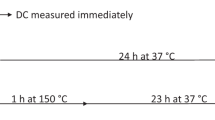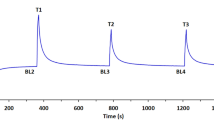Abstract
The interactive effects of ambient temperature of cure and resin composition on the extent of cure are evaluated by the measurement of percentage conversion of double bonds, heat of cure and microhardness of visible light cure dental resin systems. Three bonding agents, including two BisGMA-based resins (Command Bond, Pentron Bond) and one urethane-dimethacrylate-based resin (Coe Bond), were evaluated. The results indicate a significant effect of ambient temperature of cure and resin composition on percentage conversion, molar heat of cure and microhardness. In the temperature range of 25–60 °C, thermal activation appears to be a promising approach to improve conversion and crosslinking in dental resins. At lower ambient temperatures of cure (25 °C), urethane dimethacrylate resin undergoes higher levels of conversion than BisGMA-based resins. At higher temperatures, the percentage conversion increases with temperature in all resins. However, the molar heat of cure and hardness values show a significant increase with temperature only in BisGMA-based resins, but not in the urethane dimethacrylate resin. The difference in percentage conversion and heat of cure variation with temperature and the similarity of the latter variation with that of microhardness, probably indicates that the heat of cure is a better predictor of the extent of cure in these thermoset resins. It appears that enhanced crosslinking due to thermal activation may significantly influence the extent of cure at higher ambient temperatures.
Similar content being viewed by others
References
N. GRASSIE, in “Chemistry of degradation processes”, (Butterworths Scientific Publication, London, 1956) pp. 14, 160–226 and 255–262.
J. SODERHOLM, M. ZIGAN, M. RAGAN, W. FISCHLSCHWEIGER and M. BERGMEN,J. Dent. Res. 63 (1984) 1248
K. J. SODERHOLM, “Hydrolytic degradation of dental composites and effects of silane treatment and filler fraction on compressive strength and thermal expansion or composite”, Odontol. Diss. Umea Univ., 1984.
W. WU, E. E. TOTH, J. F. MOFFA and J. A. ELLISON,J. Dent. Res. 63 (1984) 675.
J. M. POWERS and P. L. FAN,J. Dent. Res. 59 (1980) 815.
J. M. POWERS, P. L. FAN and M. MARCOTTE,J. Dent. Res. 60 (1981) 672.
I. E. RUYTER, in “Posterior composite resin dental restorative materials”, (Minnesota Mining and Manufacturing Co., St Paul, 1985) pp. 109–135.
J. E. MCKINNEY and W. WU,J. Dent. Res. 62 (1983) 285 (Abstract no. 1047).
W. WU and J. E. MCKINNEY,J. Dent. Res. 61 (1982) 1180.
I. E. RUYTER and S. A. SVENDSEN,Acta Odontol. Scan.,36 (1978) 75.
E. ASMUSSEN,Scan. J. Dent. Res. 90 (1982) 490.
J. L. FERRACANE, “The correlation between physical properties and degree of conversion in unfilled BisGMA based dental resins”, PhD dissertation, Northwestern University, Evanston, Illinois, 1983, 314 pp.
J. L. FERRACANE,Dent. Mater. 1 (1985) 11.
J. M. ANTONNUCCI and E. E. TOTH,J. Dent. Res. 62 (1983) 121.
J. L. FERRACANE and E. H. GREENER,J. Biomed. Mater. Res. 20 (1986) 121.
E. ASMUSSEN,Scan. J. Dent. Res. 90 (1982) 484.
S. L. WENDT Jr,Quint Int. 18 (1987) 265.
S. L. WENDT Jr,Quint Int. 18 (1983) 351.
B. COVERS, S. TAHANEY and J. DAVENPORT,IADR Abstracts of Papers, Paper no. 1279, 1989.
K. F. BATCHELDER, R. S. RICHTER and T. K. VAIDYANATHAN,J. Amer. Dent. Assoc. 114 (1987) 203.
K. F. BATCHELDER, “Manipulation of clinical factors to improve bonded composite dental restorations”, MS thesis, New York University, 1987.
J. VAIDYANATHAN and Y. WU, Effect of heat on percent cure of light cure composites,Amer. Assoc. Dent. Res., Abstracts of Papers, Paper no. 959 (1989).
J. VAIDYANATHAN and T. K. VAIDYANATHAN,Trans. Soc. Biomater. 13 (1990) 7.
I. E. RUYTER and H. OYSAED,J. Biomed. Mater. Res. 21 (1987) 11.
J. P. CREEDON and W. MANZ, in “Thermal analysis”, vol. 3, Proceedings Third International Conference on Thermal Analysis, 1971, p. 145.
J. R. BAUSCH, C. DELANGE and C. L. DAVIDSON,J. Oral Rehabil. 8 (1981) 309.
Author information
Authors and Affiliations
Rights and permissions
About this article
Cite this article
Vaidyanathan, J., Vaidyanathan, T.K. Interactive effects of resin composition and ambient temperature of light curing on the percentage conversion, molar heat of cure and hardness of dental composite resins. J Mater Sci: Mater Med 3, 19–27 (1992). https://doi.org/10.1007/BF00702940
Received:
Accepted:
Issue Date:
DOI: https://doi.org/10.1007/BF00702940




